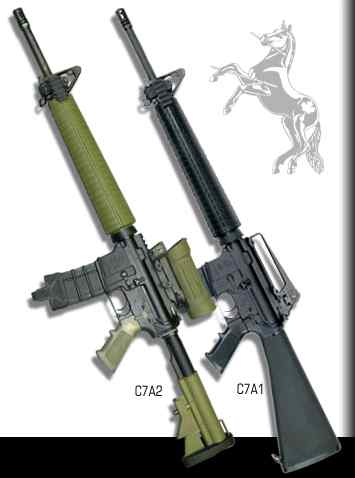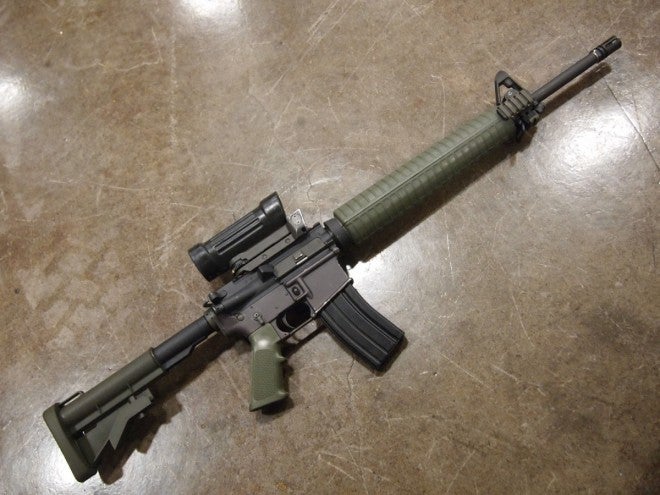According to user “RebelRouser” on AR15.com, the Canadian C7 rifle is a markedly different from the standard M16 issued to US armed forces. While the C7 is built off of the Technical Data Package from Colt, the Canadians claim to have made over 150 changes improvements to the basic rifle prior to entering production.
The most interesting nugget is the claim for barrel life. The Canadian design utilizes a proprietary steel that claims to increase barrel life 2-3 times over a chrome-lined 4150 barrel in US rifles. Further, the barrel has squeeze (reducing bore diameter over the length of the rifling) to increase accuracy.

Hi Steve
I apologize for not answering sooner. I‘m afraid I have been avoiding the
alligators chewing on my ankles to take care of the ones feeding higher up.
To answer your questions as presented:
The effective range published does not have much to do with the barrel but
is an infantry doctrine distance to do with the whole system including the
man, sights, weapon ammunition and expected employment. So when you see
effective range, it is almost always a subjective assessment of the system
capability derived by the user instructor (CTC) and rifle requirements
office (DLR), usually before the weapon is even bought. In the case of the
C7 it included iron sights and was extended (I think) when the C79 sight and
the C7A1 came along. The reference to the rifles origins (M16A1E1) is in
reference to the sight option first chosen by the CF. The heavy front
profile, 1 turn in 7inch barrel is definitely M16A2. As is the cartridge
deflector, handguards and many other changes.
Now lets talk barrels:
The C7 barrel is not the same as any M16 barrel except for the exterior
profile which is M16A2. The Material is to a formula developed here in
Diemaco (under Gov‘t contract) so that the entire bore and chamber
configuration can be integrally formed in one operation on a rotary hammer
forge. This process produces a barrel that is much stronger than the US
M16A2 barrel. The bore dimensions were developed to fire C77 ammunition,
(Chamber, bullet lead, diameters) the bore has dimensional reduction as the
bullet moves forward (squeeze) to increase life and accuracy. The bore is
plated with harder chrome than the M16. This allows greater wear life (2 to
3 times M16) and lets us machine C9 barrels from the same barrel blank. The
SFW was recently tested and purchased by the UK special forces and won in
competition against the Swiss SIG series rifles and the H&K G36 rifle. This
barrel is now in use by the Special Forces in five countries and the US Navy
Seals have expressed interest in putting them in the M4 Carbines that they
have.
We have just completed a C8 Carbine upgrade program for Canada which is a
new barrel with an improved chamber and stronger extractor spring assembly
and a weaker ejector spring. These are the same internal configuration as
our very successful SFW barrel.
Differences:
The C7 rifle and C8 Carbine is made under license with a Tech Data Package
provided by Colt to the Canadian Gov‘t. Diemaco reviewed the design and
made about 150 changes to the drawing package before Canadian production.
These are to numerous to mention her but include things like materials and
processes as well as a different barrel configuration and manufacturing
processes.
The improved handguard we designed here after CWO John Ginn kept beating the
Colt version off the weapon on the parade square. You probably can‘t tell
from the outside but if the you take the handguard off, you will notice two
types. The improved version has two large ribs under the heat shield and
three interlocking ribs on either edge as well as different material. These
were introduced late in the program so they had to be interchangable and be
a good match with the old handguard.
Another change you may notice is the small diameter front sight post that we
developed when soldiers complained that the US large square one actually
obscured the target at ranges of 300 and greater.
I hope this helps you with the discussion and thank you for your interest in
the C7.
Ian Anderson
ILS Supervisor
Product Engineering Dept.
Diemaco a division of Heroux- Devtek
Please note: Any opinions expressed or implied in this email are personal
are not necessarily those of Heroux Devtek or Diemaco
 Your Privacy Choices
Your Privacy Choices
